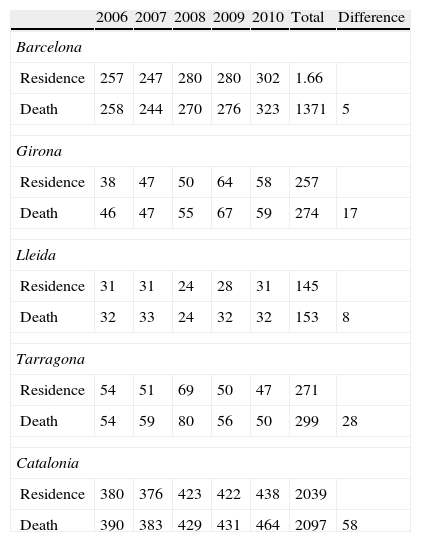With respect to the article by Giner and Guija1 on the lack of reliability in the statistical data on suicide in Spain, recently published in your journal, we would like to clarify a few key points in this information, as well as the authors’ interpretation.
As is indicated in the article, the pathway for declaring statistical data is tortuous, with many agents and organisms involved (the police, coroners, court officers, civil registry office, National Statistics Institute, regional/autonomic communities). But the reality is even more complex, due to the fact that there are numerous documents in which the essential data are gathered to reach a reliable diagnosis of the cause of death (removal of the body, autopsy reports, dispatches, online legal processes network, official statistical bulletins on judicial deaths [Boletín Estadístico de Defunción con Intervención Judicial, BEDIJ] and even statistical bulletins of “deaths from natural causes” with accompanying legal documentation).
There is a great complexity involved in these documents and the pathways, with the addition of the time that passes from the first autopsy results, through the inscription of death in the civil registry and the formalisation of the statistical document, until the time of final autopsy reports. These facts can justify the majority of the differences seen between the two sources. As the authors explain, citing Farmer,2 the number of deaths recorded as suicide (statistics) are of necessity lower than the real ones (Institutes of Forensic Medicine [Instituto de Medicina Legal, IMLs])–and this maxim is fulfilled in the great majority of the data presented in Table 2 and Figure 3 in the article. Nevertheless, based on our experience at the Register of Mortality in Catalonia, there is not insignificant number of cases in which this is not true (taking the data from the IMLs as the reference standard). For example, thanks to the recovery of information from the Catalan IML,3 we can see that, for the city of Barcelona in 2010, of 25 cases declared in the BEDIJ as suicides, 3 turned out not to be. That is why the authors’ presumption that “those [cases] identified as suicides are indeed so” seems risky to us and we cannot see that this would be a reason for doubting the reliability of forensic sources. In addition, in the same study for the city of Barcelona in 2010, it was estimated that the under-reporting of deaths from external causes would be approximately 30% and that the causes of death would vary in more than half of the deaths when autopsy information is available.3
Another key methodological aspect, which can yield important differences between the 2 sources of data, is the knowledge and treatment of the territorial variable of the cases. Information legal tends to be facilitated by the “place of the occurrence” (of the death or the discovery of the body); while, in contrast, in mortality statistics (on population) the data are given by the deceased's place of residence, given that the population at risk has to be placed in the denominator to calculate rates. This fact, which the authors do not take into consideration when calculating the rates presented in Table 3, can alter the results.4 In places with a great many non-resident individuals, this discrepancy can be important, as can be seen in the data from a statistical source in the accompanying Table 1. In Catalonia between 2006 and 2010, this means a difference of 58 more deaths by suicide according to the territory of death than according to that of residence.
Number of suicides by provinces of residence and death, Catalonia 2006–2010.
| 2006 | 2007 | 2008 | 2009 | 2010 | Total | Difference | |
| Barcelona | |||||||
| Residence | 257 | 247 | 280 | 280 | 302 | 1.66 | |
| Death | 258 | 244 | 270 | 276 | 323 | 1371 | 5 |
| Girona | |||||||
| Residence | 38 | 47 | 50 | 64 | 58 | 257 | |
| Death | 46 | 47 | 55 | 67 | 59 | 274 | 17 |
| Lleida | |||||||
| Residence | 31 | 31 | 24 | 28 | 31 | 145 | |
| Death | 32 | 33 | 24 | 32 | 32 | 153 | 8 |
| Tarragona | |||||||
| Residence | 54 | 51 | 69 | 50 | 47 | 271 | |
| Death | 54 | 59 | 80 | 56 | 50 | 299 | 28 |
| Catalonia | |||||||
| Residence | 380 | 376 | 423 | 422 | 438 | 2039 | |
| Death | 390 | 383 | 429 | 431 | 464 | 2097 | 58 |
In conclusion, we coincide with the authors in that the statistical data on suicide have reliability problems and that its causes are difficult to solve, especially when (as the study demonstrates) some IMLs still lack basic information technology tools to perform their task. We disagree with respect to the poor reliability of forensic data sources, because this assertion is based on an unverified and possibly erroneous presumption. Finally, we believe that, without an in-depth process of data recovery, it will be difficult to improve this problem, a task in which the IMLs and the autonomic community registries play a fundamental role.
Please cite this article as: Gispert R, Gallo B, Barbería E, Puigdefàbregas A, Ribas G, Medallo J. Comentarios sobre las diferencias en el número de muertes por suicidio en España. Rev Psiquiatr Salud Ment (Barc). 2014;7:208–209.






